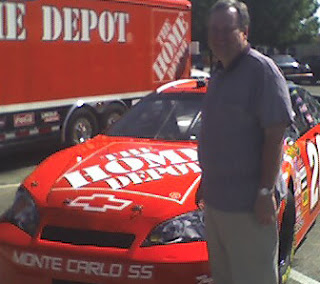Here is a picture taken after I got it fixed.

The bright O-shaped thing is in reality a nut that acts as a jam nut. The jam nut holds the black set screw in place by encircling it. The set screw tightens through the U-joint into the steering shaft. Just to the right in the picture, you can see the bottom of the pillow block (the shiny part) that is holding the bearing and steering column shaft at an angle going up to where the steering wheel will be. Anyway, the 2 shiny parts were hitting each other and shouldn't have. The solution was simple--bang on the steering column with a big rubber mallet to move the U-joints away from the pillow block.
Here is another useful picture.

In it, you can see a vertical line drawn with a silver marker on the shaft that goes through the firewall into the engine compartment. I made that mark prior to swinging my rubber mallet. You can see that where the line used to be flush against the bearing, it now shows that the shaft moved about a quarter-inch or so.
I did also have to make another slight modification. The steering column was still rubbing slightly against the dash frame. So I took it all apart again to add a couple of washers to lower the pillow block and bearing so that the shaft would not rub. Seems to work beautifully now.
I could not completely finish the steering yet, because the steering wheel cannot go on until the dash board goes in. There is a small hole in the dash for the steering shaft to pass through, but it would not go over the wheel or the hub that holds the wheel either. So later on, I will have to finalize the turn signal stuff and steering wheel.
With the shafts all in their final positions, I was able to start to look at how to fix the power steering pump location problem. Recall that I had to remove the pump to get the steering shafts in place. A first pass at looking at the situation seems to indicate that I will be okay with my current setup for the pump, but will have to get a slightly longer belt. The current one is 50.5 inches long, and has to be about an inch or so longer to accomodate the slightly raised location of the power steering pump. That had to go up just a tad in order for the hoses taking power steering fluid from the pump to the steering rack to clear the steering shaft. Unfortunately, the belt replacements come in 51 and 52 inches, not 51.5 which is what would have been easiest. I tried the 52, but it was just too long, so I returned it for a 51. That was just barely long enough, but with some serious pulling using a ratcheting tie down strap, I was able to get it to fit perfectly. There is about 3/8 inch clearance now from the steering shaft to the power steering pump hoses.

After that came the throttle cable and gas pedal. This was pretty straight forward. I got the holes drilled for mounting the pedal and for passing the throttle cable through the firewall. It goes through a stainless steel housing up to the carburetor so that when you press down on the gas pedal the cable opens up the carb a little so more air and fuel pass into the engine. I ended up drilling an extra hole into the driver's side footbox so that I could put in a clamp to hold the cable housing in place. It was very close to the steering U-joints, so I thought this would keep them from getting caught or rubbing on each other. It may look a little funny, but it is undoubtedly safer. Here are 3 pics showing the gas pedal, the housing looping around as it comes out through the firewall, and the routing up to the carburetor.




No comments:
Post a Comment